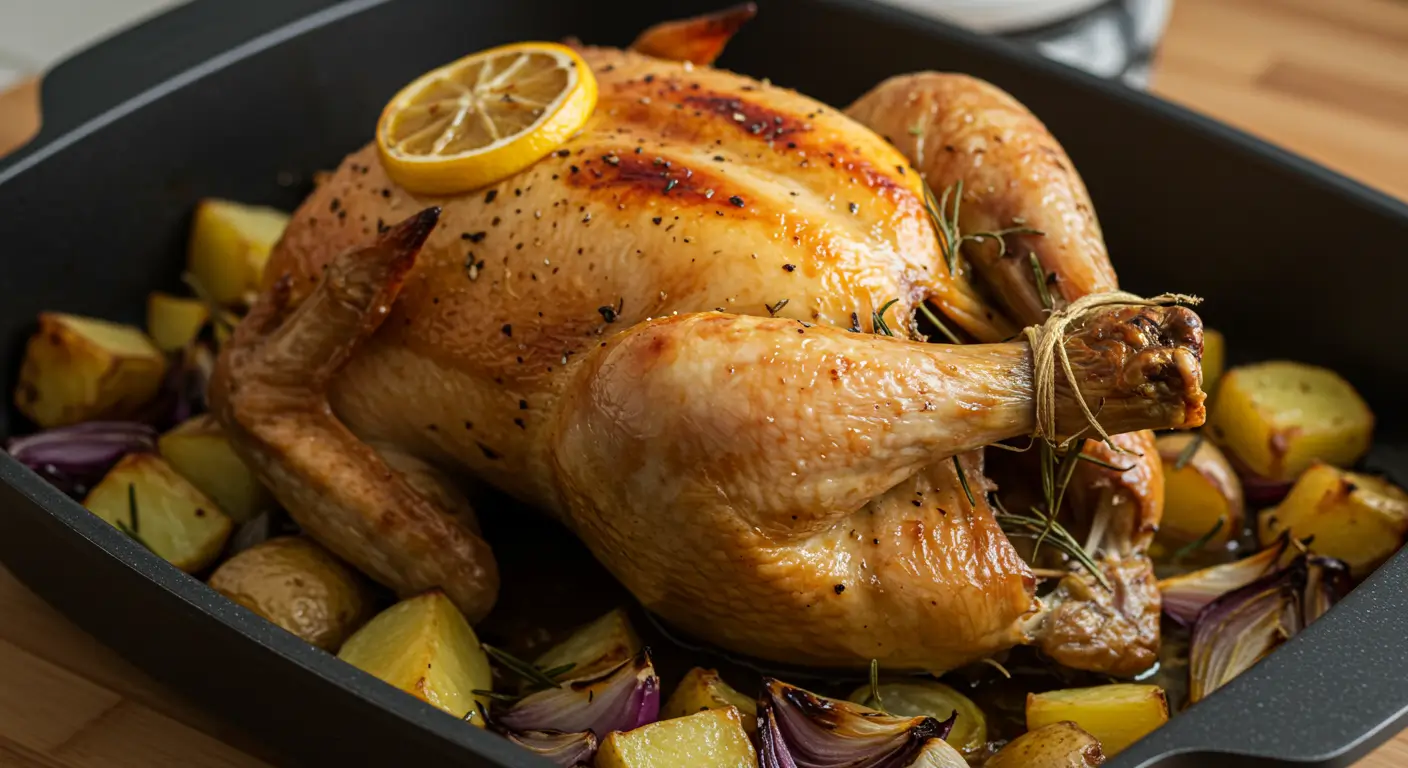Okay, confession time. I used to be terrified of cooking whole chickens. Like, genuinely scared. All those horror stories about food poisoning and dry breast meat and somehow managing to burn the outside while keeping the inside raw? Yeah, that was enough to keep me buying rotisserie chickens from the grocery store for years.
But then last spring, my friend Lisa served this incredible lemon garlic roasted chicken at her dinner party, and I literally asked for thirds. THIRDS. When’s the last time you asked for thirds of anything that wasn’t dessert? She made it look so effortless, just tossed some ingredients together and boom—restaurant-quality chicken.
Of course, when I begged for the recipe, she laughed and said, “Oh, it’s super easy! You just season it and roast it.” Thanks, Lisa. Super helpful. That’s like saying “just paint the Mona Lisa” when someone asks how to be an artist.
Table of Contents
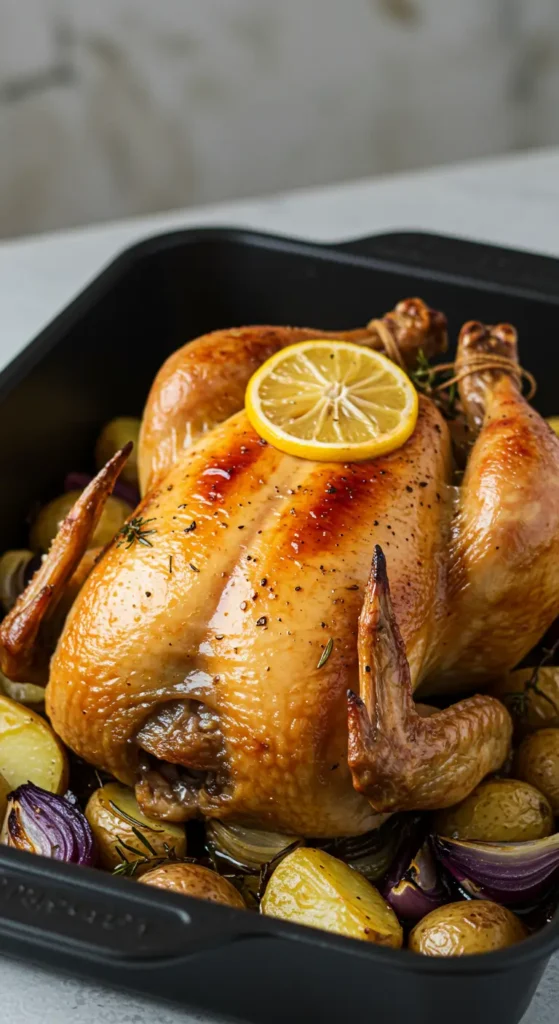
My Lemon Garlic Roasted Chicken Journey :
So I did what any reasonable person would do—I went home and immediately tried to recreate it. My first attempt was… let’s call it “educational.” I think I used way too much lemon juice, not enough garlic, and somehow managed to both overcook and undercook the same bird. My husband ate it without complaining, bless him, but I could see him subtly reaching for the hot sauce.
That was six months ago. Since then, I’ve probably roasted more chickens than a small restaurant. I’ve learned about brining (game-changer), about letting the skin dry out (crucial), and about the magic of proper seasoning distribution. Most importantly, I’ve learned that roasting a chicken really IS pretty easy once you know what you’re doing.
Now my family actually requests this chicken. My 11-year-old, who usually picks at his food like a tiny food critic, cleaned his plate last Sunday and asked if we could have it again this week.
What Makes This Recipe Actually Work :
Here’s the thing about lemon garlic chicken—it sounds simple, but there are a few key tricks that make the difference between “meh” and “holy cow, did I really make this?”
First: the lemon. You can’t just squeeze some lemon juice on a chicken and call it a day. You need the zest, you need some juice, and—this is key—you need to get some of that lemon flavor UNDER the skin, not just on top of it.
Second: the garlic situation. Raw garlic burns. Burned garlic tastes bitter. So you need to be strategic about how much garlic you use and where you put it.
Third: salt and time. This isn’t a last-minute recipe. The chicken needs time to absorb all those flavors, and the skin needs time to dry out so it actually crisps up instead of being all flabby and sad.
Shopping List :
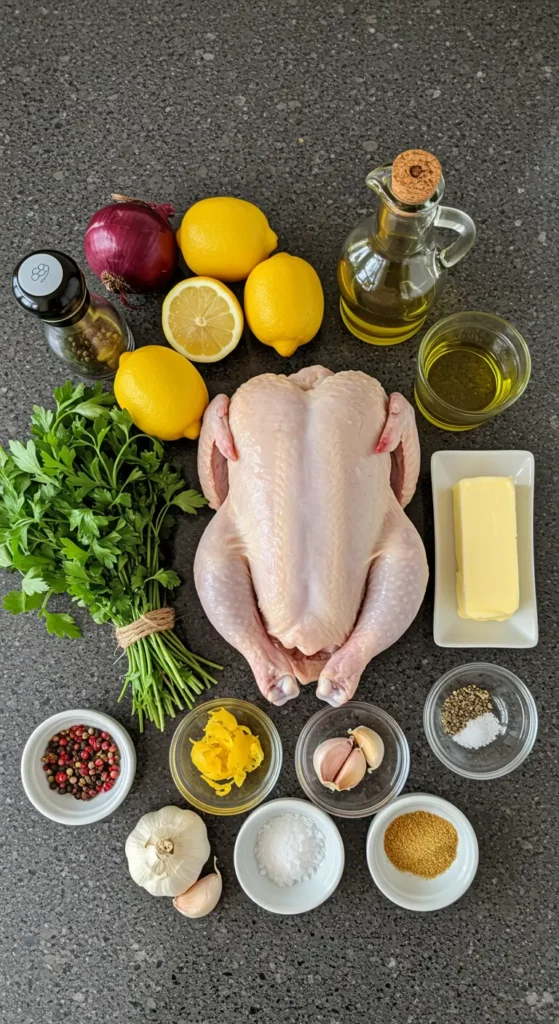
The Star:
- 1 whole chicken (3-4 lbs—don’t go bigger or the timing gets weird)
The Supporting Cast:
- 2 large lemons (get the ones that feel heavy for their size)
- 1 head of garlic (don’t buy the pre-peeled stuff, it’s not as fresh)
- 1/4 cup olive oil (the good stuff makes a difference here)
- 2 tablespoons butter, softened
- 1 tablespoon fresh thyme (or 1 teaspoon dried if that’s what you’ve got)
- 2 teaspoons kosher salt
- 1 teaspoon black pepper
- 1/2 teaspoon paprika (for color and a tiny bit of smokiness)
Optional But Recommended:
- 1 onion, quartered (goes in the pan, adds flavor)
- A few sprigs of fresh rosemary
- 1 lb baby potatoes (because why not make it a complete meal?)
Here’s my grocery store tip: when buying a whole chicken, check the sell-by date and give it a smell through the packaging. I know that sounds gross, but fresh chicken shouldn’t smell like anything. If it smells funky, even a little bit, don’t buy it.
Also, free-range or organic chickens really do taste better, but they’re expensive. If budget’s tight, a regular chicken with good seasoning will still be delicious.
The Method :
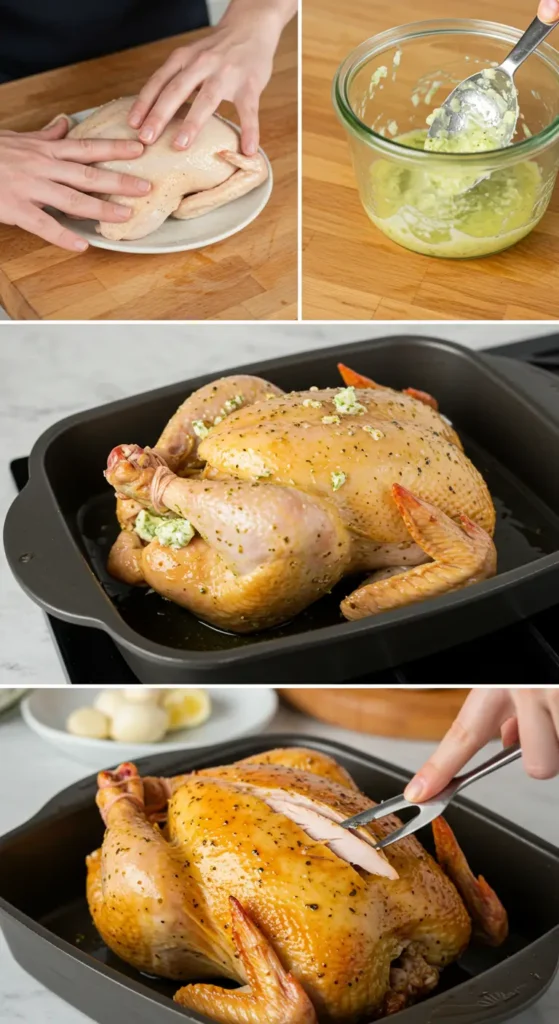
Step 1: The Prep Work (Do This First Thing in the Morning) Take your chicken out of the fridge about 30 minutes before you start cooking. Cold chicken doesn’t cook evenly.
Pat that bird completely dry with paper towels. I mean really dry—inside and out. This is crucial for crispy skin. Nobody wants rubbery chicken skin.
Step 2: The Lemon Garlic Magic Zest both lemons (save the zest!), then cut one lemon into quarters and juice the other one. You’ll need about 3 tablespoons of juice.
Mince 4-5 garlic cloves really fine. Mix the minced garlic with the softened butter, lemon zest, thyme, salt, pepper, and paprika. This is your flavor bomb paste.
Step 3: Get Under That Skin (This Is Where the Magic Happens) Now comes the slightly awkward part. You need to gently separate the skin from the breast meat. Slide your fingers under the skin at the neck end and work your way down, being careful not to tear it.
Rub about half of your garlic-lemon butter mixture under the skin, directly onto the meat. This is what makes the difference between good chicken and incredible chicken.
Step 4: Season Everything Else Rub the rest of the butter mixture all over the outside of the chicken. Stuff the lemon quarters and a few whole garlic cloves inside the cavity. Tie the legs together with kitchen twine if you have it (if not, don’t stress—it’s more for looks than function).
Drizzle with olive oil and season generously with salt and pepper.
Step 5: The Roasting Game Preheat your oven to 425°F. If you’re adding potatoes and onions, toss them with olive oil, salt, and pepper and scatter them around the chicken in a roasting pan.
Roast for about 60-75 minutes, until the internal temperature hits 165°F in the thickest part of the thigh. The skin should be golden brown and crispy.
Here’s the hardest part: let it rest for 10-15 minutes before carving. I know it smells amazing and you want to dive right in, but trust me—the juices need time to redistribute.
My Favorite Variations :
The “Mediterranean Madness”: Add kalamata olives, cherry tomatoes, and crumbled feta to the roasting pan. Use oregano instead of thyme. Tastes like vacation.
The “Herb Garden Special”: Go crazy with fresh herbs—rosemary, sage, thyme, whatever you’ve got. Mix them into the butter mixture and stuff some inside the cavity too.
The “Spicy Situation”: Add some red pepper flakes to the butter mixture and use smoked paprika instead of regular. Not too spicy, just a nice little kick.
The “Root Vegetable Bonanza”: Throw in carrots, parsnips, and sweet potatoes along with the regular potatoes. Everything roasts together and tastes amazing.
Things I Wish I’d Known From the Start :
Don’t skip the meat thermometer. Seriously. I used to try to guess when it was done based on how it looked, and I was wrong about 50% of the time. A $10 thermometer will save you from serving raw chicken or turning it into leather.
If the skin starts browning too fast, tent it with foil. Better to have slightly less crispy skin than burnt chicken.
That white stuff that sometimes comes out of the chicken while it’s cooking? That’s just protein, not a sign that something’s wrong. It happens with really fresh chicken.
Save the drippings! They make incredible gravy, or you can just drizzle them over the potatoes. Liquid gold, I tell you.
The Leftovers Situation :
This chicken makes fantastic leftovers, which is good because unless you have a family of six, you’re probably going to have some. The meat stays moist and flavorful, and it’s perfect for:
- Chicken salad sandwiches (the lemon flavor is perfect for this)
- Thrown into pasta with some of the leftover roasted vegetables
- Soup (use the bones to make stock—waste not, want not)
- Quesadillas with some of those roasted onions
Pro tip: save the carcass and make stock. I know it sounds fancy and intimidating, but you literally just throw it in a pot with some vegetables and water and let it simmer. Future you will thank present you.
Why This Became My Go-To Sunday Dinner :
Here’s the thing about roast chicken—it feels special without being complicated. It makes your house smell incredible, it feeds a crowd (or provides lots of leftovers), and it’s actually pretty hard to mess up once you know what you’re doing.
My kids love it because it tastes like “restaurant chicken” but better. My husband loves it because I’m usually in a good mood when I make it (success in the kitchen does that to me). And I love it because it makes me feel like I actually know how to cook.
Plus, there’s something deeply satisfying about carving a whole chicken. It’s primal or something. Like you’re channeling your inner pioneer woman, except with a meat thermometer and a gas oven.
The Real Talk About Roasting Chicken :
Look, I’m not going to pretend this is health food. There’s butter under the skin and olive oil everywhere. But it’s real food made with real ingredients, and that counts for something in my book.
It’s also way cheaper than buying rotisserie chickens all the time, and you control the salt content and know exactly what goes into it. Plus, the satisfaction factor is huge. There’s something about pulling a golden, crispy chicken out of your own oven that just feels like winning at life.
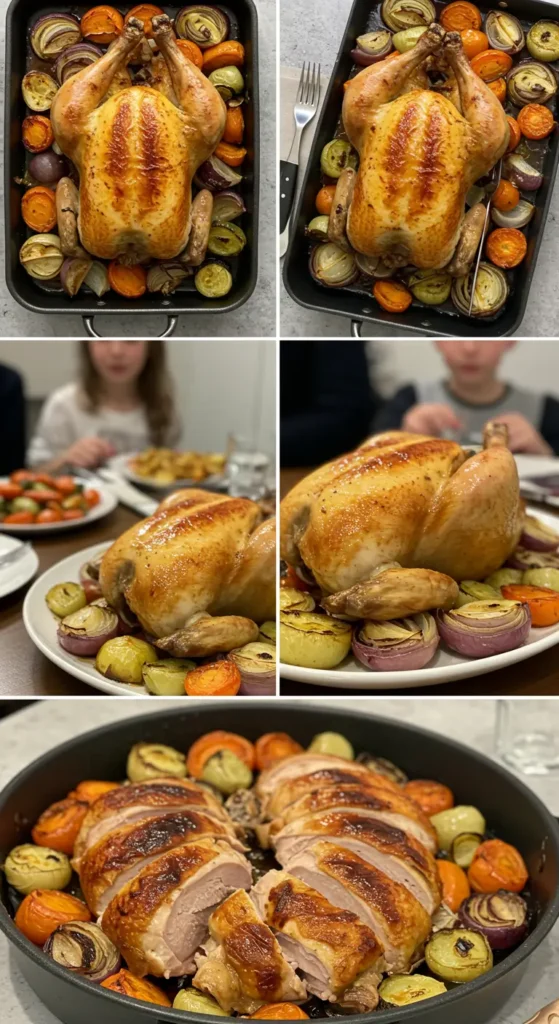
Final Thoughts :
If you’ve been intimidated by whole chickens like I was, this is your gateway recipe. It’s forgiving, it’s delicious, and it’ll make you feel like a real cook even if you’re secretly Googling “how to tell if chicken is done” on your phone.
The prep work is minimal, most of the time is hands-off roasting time, and the results are seriously impressive. Your family will think you’ve been secretly taking cooking classes.
Start with this basic recipe, get comfortable with the technique, then experiment with different herbs and vegetables. Before you know it, you’ll be that person who “just whips up a roast chicken” for Sunday dinner.
And trust me—once you taste homemade roast chicken with crispy skin and juicy, flavorful meat, you’ll never want to buy another sad rotisserie chicken again.
Happy roasting! (And may your chicken skin always be crispy and your meat thermometer always be accurate.)
P.S. – Seriously, get a meat thermometer if you don’t have one. It’s the difference between anxiety and confidence when it comes to cooking chicken.
Lemon Garlic Roasted Chicken
Perfectly roasted whole chicken with crispy skin and juicy meat, flavored with fresh lemon, garlic, and herbs. This foolproof recipe includes tips for achieving restaurant-quality results at home.
Ingredients
- 1 whole chicken (3-4 lbs)
- 2 large lemons
- 1 head garlic
- 1/4 cup olive oil
- 2 tablespoons butter, softened
- 1 tablespoon fresh thyme
- 2 teaspoons kosher salt
- 1 teaspoon black pepper
- 1/2 teaspoon paprika
- 1 onion, quartered (optional)
- 1 lb baby potatoes (optional)
Instructions
-
Step 1Remove chicken from refrigerator 30 minutes before cooking. Pat completely dry inside and out with paper towels.
-
Step 2Preheat oven to 425°F (220°C). Zest both lemons, quarter one lemon, and juice the other (about 3 tablespoons).
-
Step 3Mince 4-5 garlic cloves and mix with softened butter, lemon zest, thyme, salt, pepper, and paprika to create flavored butter.
-
Step 4Gently separate skin from breast meat. Rub half the garlic-lemon butter under the skin directly onto the meat.
-
Step 5Rub remaining butter mixture all over the outside of the chicken. Stuff lemon quarters and whole garlic cloves inside cavity.
-
Step 6Tie legs together with kitchen twine. Drizzle with olive oil and season generously with salt and pepper.
-
Step 7Place in roasting pan with optional vegetables around the chicken. Roast for 60-75 minutes until internal temperature reaches 165°F (74°C).
-
Step 8Let rest for 10-15 minutes before carving to allow juices to redistribute.

